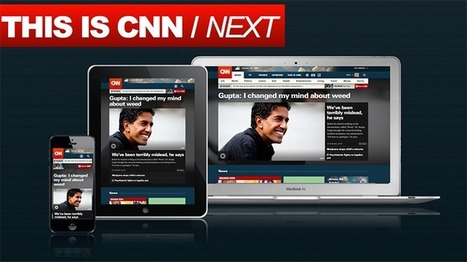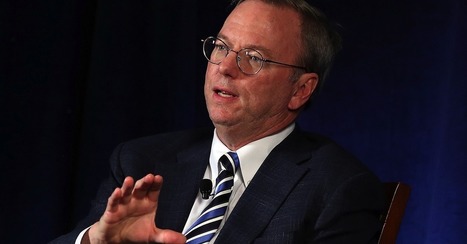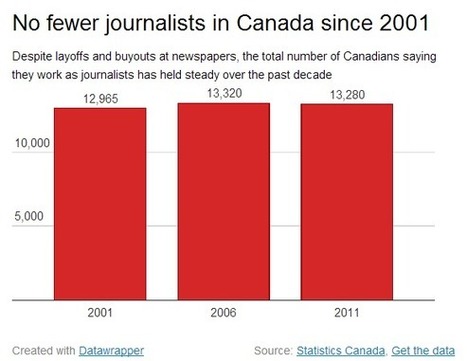 Your new post is loading...
 Your new post is loading...
Sharing quality content with their audience, engaging with readers below the line and building their brand, these are just some of the tips for new journalists shared at a journalism event today.
Speaking at the NCTJ's Journalism Skills Conference at Bournemouth University, a panel were asked to give advice to journalists, particularly those entering the field.
The panel featured Peter Bale, vice president and general manager of CNN International Digital; Pete Clifton, executive producer for MSN UK; and Liisa Rohumaa, a journalism lecturer at Bournemouth University...
When considering the future of print, remember that 80% of Canadians read newspaper content every week. The number of those who only access this content through digital formats is rising, of course. But one thing remains consistent: the belief that newspapers are a credible and comprehensive source of information.
Newspaper reading habits have changed in the past few years. No one would argue that point.
But it is often human nature to exaggerate the pace and degree of change. That, of course, is good if you need the push to re-invent yourself but less helpful if you are the one who has to manage the transition...
Across the country, newspapers are leaving their old haunts and shifting to cheaper buildings — and taking the opportunity to reshape how their newsrooms look.
... An upcoming white paper I’m writing for Tow will look further into how these space changes facilitate breaking news, but for now, suffice it to say that this kind of organization creates a centralized production and distribution platform for newsrooms hungry to stay on top of the latest.Other newsrooms are taking the opportunity to brand moves as organizational change as well, looking beyond nostalgia.
In an article announcing its move, the Syracuse Post-Standard’s headline read “Syracuse Media Group’s move signals shift to digital-first focus for news and ads.” As the lede put it: “Goodbye, cubicles and copy editors. Hello, collaborative work space and curators.”...
A look at some of the ways in which mobile journalism, drone journalism, social media and crowdsourcing is being maximised by investigative journalists...
What happens when the age-old practice of investigative journalism collides with emerging technologies and new media?Potentially powerful things, according to a panel at yesterday's BBC social media conference, which looked at some innovative ways investigative reporters are using the latest technology to power their journalism....
Curation is a relatively new term in journalism, but the practice is as old as journalism itself. Every act of journalism is an act of curation: think of how a news report or feature selects and combines elements from a range of sources (first hand sources, background facts, first or second hand colour). Not only that: every act of publishing is, too: selecting and combining different types of content to ensure a news or content ‘mix’.
Amazon’s Jeff Bezos’ in his talk to employees at the Washington Post said: “People will buy a package … they will not pay for a story.” Previously that package was limited to what your staff produced, and wire copy. But as more content becomes digitised, it is possible to combine more content from a wider variety of sources in a range of media - and on any one of a number of platforms.
Curation is nothing new – but it is becoming harder...
BuzzFeed CEO Jonah Peretti just sent a memo to his employees about the company's growth and its plans for the coming year, and it was loaded with some pretty impressive numbers. August was apparently a big month for BuzzFeed, with record traffic of 85 million unique visitors. For contrast, Twitter gets about 91 million U.S. users per month and Amazon gets 77 million U.S. users, according to Quantcast.
Based on U.S. users alone, BuzzFeed has ~41 million users, bigger than Craigslist or AOL.The company saw a record profit as well (no numbers disclosed, but Peretti says that the company went from "zero revenue four years ago to a profitable company with over 300 employees")....
This is what UPI's 100 years of journalistic excellence has pathetically come down to.... - 4 of its top stories are about misbehaving celebrities. The other is about whether a naked photo that went viral was staged. - 4 of its top stories are about naked people; 2 of its top stories contradict each other. And considering that the 5th story could have been fact-checked by just watching the video in question, that means UPI ran a story for hits without even watching the video. - 3 of the stories are not even about Miley Cyrus, they’re about celebrity reactions to her routine....
That’s what the surveillance state is trying to do. It has the means, the will and the latitude to go after journalism the way the way it went after terrorism. Only a more activist press stands a chance of resisting this.Last week, the novelist and former CIA operative Barry Eisler published one of the most important posts I have read about what’s happening to the press since the Snowden revelations began in early June.
In it, he tries to explain why authorities in the UK detained Brazilian national David Miranda for nine hours at Heathrow airport and confiscated all the technology he had on him. (Miranda, as everyone following the story knows, is the spouse of The Guardian columnist Glenn Greenwald. He had been acting as a courier, bringing documents on encrypted thumb drives back and forth between Greenwald in Brazil and his collaborator, Laura Poitras, in Germany.)Eisler’s explanation of this pivotal event is the most persuasive I have seen....
...Today, the delivery of news is not so defined. Website, social media and digital platforms have profoundly changed not only how we get our news, but also what news we are getting. The comment section of online news stories are often more popular, or at least more entertaining, than the actual news story. The ability to “like” and “share” news now allows others to instantaneously watch or read what we are following.
As the number of online and social media offerings grows, we are sadly seeing the demise of newspapers. In 2011, 152 American newspapers ceased operations. Rapidly declining advertising revenues continue to be the industry’s core problem as the majority of us seek our news online.
Now, plans are in place for significant changes for CNN.com and CNN digital platforms. The channel will launch a redesigned website (see screenshots here) and install a back-end system that its editorial producers can utilize. This comes after the recent merging of their digital and television newsrooms into one entity. With a new emphasis on their talent, CNN anchors, reporters and writers will become more prominent, enabling the sharing of content across platforms....
In the wake of the Boston Marathon bombing one commenter called it a “watershed moment for social media” – but not in a good way. “Legions of Web sleuths cast suspicion on at least four innocent people, spread innumerable bad tips and heightened the sense of panic and paranoia,” wrote Ken Bensinger and Andrea Chang in the L.A. Times. In a similar post, Alan Mutter quipped that crowd reporting after the Boston Marathon went from critical mass to critical mess.
Recent events like Hurricane Sandy and the Boston marathon bombing have cast a harsh spotlight on the brave new world of breaking news and highlighted the critical need for better tools and techniques for verifying and making sense of the flood of information these events produce. This has all played into the ongoing debate about whether the Internet and new technology erode our standards and our trust in newsgathering....
The question that still remains is why: Why would a technology entrepreneur invest in a stodgy media outlet in a declining industry? Was the motive for the move sentimental altruism or profit?
I think Henry Blodget at Business Insider hit the nail on the head in his piece when he said that:"Content and commerce companies have long dabbled with combining the two experiences, but no one has really nailed it. Given Amazon’s expertise in affiliate marketing and advertising, it’s not hard to imagine that the Washington Post could quickly become a laboratory for the next generation of integrated content and commerce."...
The Kindle Singles store, according to its editor David Blum, is “like a bookstore where the manager also edits the books.” Blum is that manager-editor, and under his guidance the store has grown to feature nearly 400 works since launching in January 2011. When the store went live, its mission was to publish the kind of long-form journalism that has become harder to find as more magazines have shuttered and those still standing allocate fewer pages to in-depth pieces.
Since the Singles program started, it has gained enough respect to attract major names—among the many heavy hitters who’ve released Singles are Christopher Hitchens and Stephen King—and to delve into fiction.
Blum, a veteran of alternative weeklies—he worked at both the Village Voice and the New York Press, during the papers’ headier days—has gained a fair amount of attention since the store took off. In an April profile in the New York Times, Leslie Kaufman wrote that he has “transformed himself from doctor of the dying to midwife of the up-and-coming,” becoming “a man whom authors want to court.”...
Innovative storytelling, audience engagement, and financial flexibility are key ingredients for newspapers to cope with pressures from competitors, budget constraints, and the speed at which technology is changing."It came as no surprise when The New York Times took home a Pulitzer for 'Snow Fall' - the immersive multimedia package impressed journalists and web designers alike with its seamless integration of text, audio, videos, photos and interactive graphics."The comments in "Trends in Newsrooms 2013," the World Editors Forum's report on the state of the news industry, about the attention-grabbing content, underlined the importance of stories that jump out at readers....
|
...The news, broken by Bloomberg’s Edmund Lee, that once mighty Forbes is going on the block after 96 years of mostly family ownership, has evoked mostly shrugs—another day, another fire sale of a journalism icon—with much of the discussion surrounding how well Bono and other minority investors have done from their investment. That, and what to do with the carcass.
The asking price of $400 million would represent at best a salvage operation for both the Forbes family and Elevation Partners, which includes Bono and former Apple executive Fred Anderson, and which paid, according to Fortune’s Dan Primack, $265 million (higher than previous reports) for its 45 percent stake back in 2006, valuing the company at $588 million. Elevation has already written down its investment by 75 percent.
If Forbes doesn’t get its asking price, it won’t be for lack of effort. Since 2010, the Forbes story has been a strenuous effort to reinvent itself as a digital media innovator, creating easily the most frenetic site in business news. It has assembled an army of 1,200 (that’s one thousand, two hundred) mostly bloggers producing dozens of posts a day (a mere 45 between 5pm Saturday and 5pm Sunday; e.g. “Practical jet packs finally take off”); embracing native advertising, the ethically problematic mixing of ads and editorial, to an extent few mainstream outlets have; amping up its conferencing business (itself not without problems), among other things....
I’ve been worried about this. Information should be free – not in the sense that it should cost me nothing, but in the sense that it should cost me nothing, but in the sense that I should be able to access a variety of news sources, so that my view of the world is not coming from one source alone. If I have to pay per news source, I have an incentive to limit my news consumption, to let just one small group of people filter my world for me.
The great strength of online news is the possibility of aggregating across sources. I am willing to pay for that. I pay for NewsBlur, although it is far from my ideal RSS service. I would gladly have paid for Google Reader...
The Forbes website, or "platform", as Lewis D'Vorkin, chief product officer for the media outlet, prefers to call it, publishes hundreds of articles a day, powered by not just its own journalists but a community of 1,300 contributors and a dozen brands producing "thought-leadership content".
Speaking at an event on Wednesday (30 October), held at the Telegraph, D'Vorkin discussed in detail the site's content strategy, which is based on the editorial pillars of "context, relevance and analysis".
Strikingly, it is seeing much success in resurfacing past content, with 50 per cent of its monthly traffic said to be to articles that are at least 30 days old.The "more quality content we produce, the more variety we produce, the more long-tail of content we have," he added.But the approach taken by Forbes demonstrates that it is not just a newsroom's own reporters who can achieve this....
Eric Schmidt has seen the future of magazines, and it's on the tablet....
...Five years from now, the world will have "powerful, tablet-looking things — [devices] that look roughly like a tablet — as a substitute for traditional media," Schmidt predicted. Those tablets will have apps that are "incredibly immersive," including magazine apps, which will take advantage of people's social graphs, location data and other features to offer a more interactive experience, he said....
Amazon CEO Jeff Bezos says he sees a future in which newspapers are like horses — a luxury item for a small group of people, not a mainstream transportation method — but his analogy is both right and wrong.
As tech watchers debate the overuse of interactive tools in stories David Sarno says light interactive news stories don't go far enough. As a tech reporter at the Los Angeles Times David Sarno found himself frustrated that newspaper stories only engage “one lousy sense,” as he puts it. That would be sight.
Why couldn’t they be as interactive and entertaining as a video game like Grand Theft Auto, where a player can walk around a virtual city, drive a car, walk into a store (and, yes, kill people), and essentially have some control over a re-created reality?
Even when the iPad came out in 2010 (an event that Sarno prolifically covered for The Times) and made print media more touchable, Sarno wasn’t impressed. “At that time, and still largely today, what news organizations and magazines are doing is reproducing the print version on the screen,” he tells Fast Company. “It’s like two steps better than scanning in the print version and putting it on the iPad screen.”...
The New York Times is in the Snowden game.The paper — which NSA leaker Edward Snowden deliberately avoided over his fear that it would cooperate with the United States government — is now working with the Guardian on a series of stories based on documents that detail National Security Agency cooperation with its British counterpart, the Government Communications Headquarters, known as GCHQ.
"In a climate of intense pressure from the UK government, The Guardian decided to bring in a US partner to work on the GCHQ documents provided by Edward Snowden," Guardian spokeswoman Jennifer Lindenauer said in an email. "We are continuing to work in partnership with the NYT and others to report these stories."...
Chad Skelton does a good job of explaining it. There are just as many journalists working in Canada today as there were a decade ago, according to data from Statistics Canada....
Dear Jeff [Bezos],While it might seem an awful cliche, the fact of the matter is — if you go back to a time long before the commercial Internet existed, and well before you became so rich that you have $250 million in spare change to purchase a major metropolitan newspaper — I started my real journalism career in the mailroom at the Washington Post.
On the storied fifth floor of the Post’s longtime building at 15th and L Streets, NW — which is now also prepping to be sold for about half of what you forked over for the Post itself (oh, the irony!) — I delivered piles of letters and packages to reporters and editors, starting when I was still a student at Georgetown University.
I had come there as both a mailroom lackey and also as a stringer, after I called and chewed out then-Metro editor Larry Kramer (now the editor publisher of USA Today) about how badly the newspaper was covering the area’s colleges, including mine. He told me to come down to the Post and say it to his face, which I did with all the obnoxiousness a 19-year-old could muster.
As it turned out, I ended up staying at the Post — with a few short departures for things like graduate school — for almost 15 years, in more jobs than I can remember, including the lowest rung in the then-backwater business section. .PS Don't forget to breathe.
... However, it would be a mistake to think that just because it’s easier than ever to produce amazing digital editorial experiences that this makes organisational change easy. It takes an entirely different set of skills to get buy-in from stakeholders or to Jedi mind trick the empire builders of senior management. It is hard, and even I underestimated the size and nature of the challenge as I transitioned from young digital maverick field journalist to digital editor in the middle of the last decade.
While a lot is different in 2013 than it was in 1996 when I started in digital journalism, or even than it was five or six years ago, change still is hard. In some ways, it is even harder now as most newspapers struggle with redeploying diminishing resources carefully from the core business to new digital initiatives. The politics are fierce. Even when it is in an organisation’s best interest, even when it is an organisation’s stated interest to embrace digital, winning the political and cultural battles is hard, thankless work. I know people who stayed and fought these battles inside organisations, and I have deep respect for them and learn from them whenever possible. When I return to working for an organisation, hopefully soon, I will take lessons that I’ve learned from these friends....
The New York Times Company did the world of journalism a big favor today.The company finally disclosed the exact revenues of its digital business.The numbers were impressive. And they made clear that no one ever needs to fret about the future of journalism again.Specifically, the New York Times reported that the revenue of its digital business is now about $360 million a year....
|



 Your new post is loading...
Your new post is loading...


































Acompanhar a mundança!